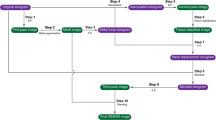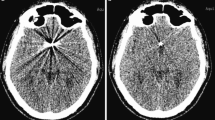Abstract
Purpose
The aim of the present study was to assess image quality improvement using a metal artifact reduction (MAR) algorithm in cases of medium or large cerebral aneurysms treated with stent-assisted coil embolization (SAC), and to analyze factors associated with the usefulness of the MAR algorithm.
Methods
We retrospectively evaluated the cone-beam computed tomography (CBCT) data sets of 18 patients with cerebral aneurysms treated with SAC. For subjective analysis, images of all cases with and without MAR processing were evaluated by five neurosurgeons based on four criteria using a five-point scale. For objective analysis, the CT values of all cases with and without MAR processing were calculated. In addition, we assessed factors associated with the usefulness of the MAR by analyzing the nine cases in which the median score for criterion 1 improved by more than two points.
Results
MAR processing improved the median scores for all four criteria in 17/18 cases (94.4%). Mean CT values of the region of interest at the site influenced by metal artifacts were significantly reduced after MAR processing. The maximum diameter of the coil mass (< 17 mm; odds ratio [OR], 4.0; 95% confidence interval [CI], 1.2–13.9; p = 0.02) and vessel length covered by metal artifacts (< 24 mm; OR, 2.3; 95% CI, 1.1–4.7; p = 0.03) was significantly associated with the usefulness of the MAR.
Conclusions
This study suggests the feasibility of a MAR algorithm to improve the image quality of CBCT images in patients who have undergone SAC for medium or large aneurysms.




Similar content being viewed by others
Abbreviations
- AchA:
-
Anterior choroidal artery
- AcomA:
-
Anterior communicating artery
- BA:
-
Basilar artery
- cav:
-
Cavernous sinus
- CE-CBCT:
-
Contrast-enhanced cone-beam computed tomography
- FOV:
-
Field of view
- HU:
-
Hounsfield unit
- ICA:
-
Internal carotid artery
- IQR:
-
Interquartile range
- MAR:
-
Metal artifact reduction
- MCA:
-
Middle cerebral artery
- MIP:
-
Maximum intensity projection
- Pcom:
-
Posterior communicating artery
- ROC:
-
Receiver operating characteristic
- RR:
-
Relative risk
- SAC:
-
Stent-assisted coil embolization
- SCA:
-
Superior cerebellar artery
- SD:
-
Standard deviation
- SHA:
-
Superior hypophyseal artery
- VA:
-
Vertebral artery
References
Buhk JH, Kallenberg K, Mohr A, Dechent P, Knauth M (2009) Evaluation of angiographic computed tomography in the follow-up after endovascular treatment of cerebral aneurysms-a comparative study with DSA and TOF-MRA. Eur Radiol 19:430–436
Clarençon F, Piotin M, Pistocchi S, Babic D, Blanc R (2012) Evaluation of stent visibility by flat panel detector CT in patients treated for intracranial aneurysms. Neuroradiol 54:1121–1125
Flood TF, van der Bom IMJ, Strittmatter L, Puri AS, Hendricks GM, Wakhloo AK et al (2015) Quantitative analysis of high-resolution, contrast-enhanced, cone-beam CT for the detection of intracranial in-stent hyperplasia. J NeuroIntervent Surg 7:118–125
Rechter G, Engelhorn T, Struffert T, Doelken M, Ganslandt O, Hornegger J et al (2007) Flat panel detector angiographic CT for stent-assisted coil embolization of broad-based cerebral aneurysms. AJNR Am J Neuroradiol 28:1902–1908
Prell D, Kyriakou Y, Struffert T, Dörfler A, Kalender WA (2010) Metal artifact reduction for clipping and coiling in interventional C-arm CT. AJNR Am J Neuroradiol 31:634–639
Van der Bom IM, Hou SY, Puri AS, Spilberg G, Ruijters D, van de Haar P et al (2013) Reduction of coil mass artifacts in high-resolution flat detector conebeam CT of cerebral stent-assisted coiling. AJNR Am J Neuroradiol 34:2163–2170
Psychogios MN, Scholz B, Rohkohl C, Kyriakou Y, Mohr A, Schramm P et al (2013) Impact of a new metal artefact reduction algorithm in the noninvasive follow-up of intracranial clips, coils, and stents with flat-panel angiographic CTA: initial results. Neuroradiol 55:813–818
Stidd DA, Theessen H, Deng Y, Li Y, Scholz B, Rohkohl C et al (2014) Evaluation of a metal artifacts reduction algorithm applied to postinterventional flat panel detector CT imaging. AJNR Am J Neuroradiol 35:2164–2169
Hung SC, Wu CC, Lin CJ, Guo WY, Luo CB, Chang FC et al (2014) Artifact reduction of different metallic implants in flat detector C-arm CT. AJNR Am J Neuroradiol 35:1288–1292
Yuki I, Kambayashi Y, Ikemrura A, Abe Y, Kan I, Mohamed A et al (2016) High resolution C-arm CT and metal artifact reduction software: a novel imaging modality for analyzing aneurysms treated with stent-assisted coil embolization. AJNR Am J Neuroradiol 37:317–323
Chintalapani G, Chinnadurai P, Srinivasan V, Chen SR, Shaltoni H, Morsi H (2016) Evaluation of C-arm CT metal artifact reduction algorithm during intra-aneurysmal coil embolization: assessment of brain parenchyma, stents and flow-diverters. Eur J Radiol 85:1312–1321
Enomoto Y, Yamauchi K, Asano T, Otani K, Iwama T (2018) Effect of metal artifact reduction software on image quality of C-arm cone-beam computed tomography during intracranial aneurysm treatment. Interv Neuroradiol 24:303–308
Zhang Q, Zhao H, Sun Q, Han J, Zhang H, Shan T et al (2019) Clinical evaluation of volume of interest imaging combined with metal artifact reduction reconstruction techniques in coiling and stent assisted coiling during neurointerventional procedures. J Neurointerv Surg 11:205–210
Acknowledgments
We thank Mr. C. Dahmani and Mr. I. Kojima (Siemens Healthcare) for technical support related to the metal artifact reduction software.
Funding
This study was funded by Siemens Healthcare.
Author information
Authors and Affiliations
Corresponding author
Ethics declarations
Conflict of interest
The authors have received research grants from Siemens Healthcare. YT and MH–RELATED: Grant: Siemens Healthcare; Support for travel to meetings for the study and provision of writing assistance. KS–RELATED: Grant: Siemens Healthcare; Support for travel to meeting for the study and payment for lectures.
Ethical approval
All procedures performed in studies involving human participants were in accordance with the ethical standards of the institutional and/or national research committee and with the 1964 Helsinki Declaration and its later amendments or comparable ethical standards. For this type of study, formal consent is not required.
Informed consent
Informed consent was obtained from all individual participants included in the study.
Additional information
Publisher’s note
Springer Nature remains neutral with regard to jurisdictional claims in published maps and institutional affiliations.
Rights and permissions
About this article
Cite this article
Murai, S., Hiramatsu, M., Takasugi, Y. et al. Metal artifact reduction algorithm for image quality improvement of cone-beam CT images of medium or large cerebral aneurysms treated with stent-assisted coil embolization. Neuroradiology 62, 89–96 (2020). https://doi.org/10.1007/s00234-019-02297-8
Received:
Accepted:
Published:
Issue Date:
DOI: https://doi.org/10.1007/s00234-019-02297-8




